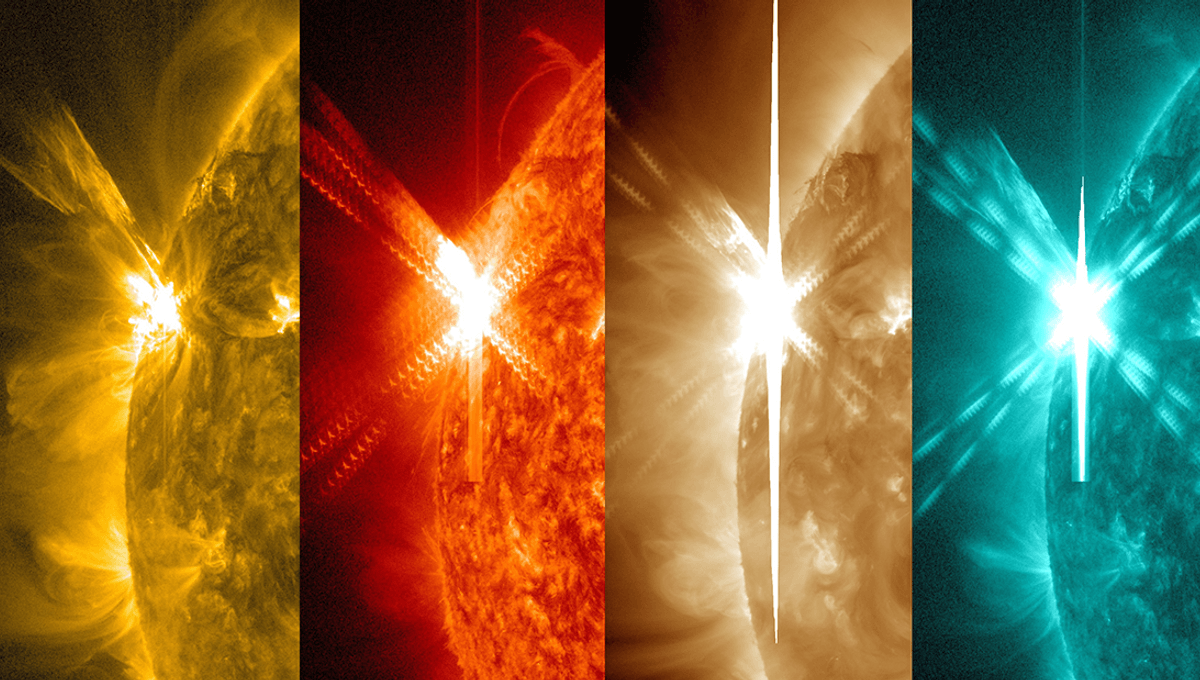
A new study looking at solar flares may have solved a 50-year-old mystery about our host star, finding that solar flares may be far hotter than we realized.
Solar flares are a common event on the Sun’s surface. They can be seen regularly throughout the year, and particularly during the solar maximum phase of the Sun’s cycle.
“A solar flare is an intense burst of radiation coming from the release of magnetic energy associated with sunspots. Flares are our solar system’s largest explosive events. They are seen as bright areas on the Sun and they can last from minutes to hours,” NASA explains. “We typically see a solar flare by the photons (or light) it releases, at most every wavelength of the spectrum. The primary ways we monitor flares are in x-rays and optical light. Flares are also sites where particles (electrons, protons, and heavier particles) are accelerated.”
Solar flares have been studied since they were first discovered in 1859 during the Carrington Event, the largest solar storm we have witnessed. Despite this, there are still a number of mysteries to be solved. One which has puzzled scientists since the 1970s is the spectral lines from these flares.
Looking at the light from stellar sources and splitting it up into its spectra will reveal bright and dark patches, known as spectral lines. Looking at what is brighter can reveal emission, while the darker bands can reveal what elements have absorbed the light on its journey. While we have a pretty good idea of the Sun’s composition (thank you, 1868 eclipse), there is a mystery surrounding why extreme-ultraviolet and X-ray light spectral lines from solar flares are so broad.
In the new work, scientists from the University of St Andrews in the UK believe they may have found an answer to this mystery. They were attempting to answer how solar flares heat plasma to over 10 million Kelvin. But, according to the team’s paper, ions in the Sun’s plasma can actually be heated to over 60 million Kelvin, while electrons remain (relatively) cooler.
“We were excited by recent discoveries that a process called magnetic reconnection heats ions 6.5 times as much as electrons. This appears to be a universal law, and it has been confirmed in near-Earth space, the solar wind and computer simulations. However, nobody had previously connected work in those fields to solar flares,” Dr Alexander Russell, Senior Lecturer in Solar Theory from the School of Mathematics and Statistics at the University of St Andrews, explained in a statement.
“Solar physics has historically assumed that ions and electrons must have the same temperature. However, redoing calculations with modern data, we found that ion and electron temperature differences can last for as long as tens of minutes in important parts of solar flares, opening the way to consider super-hot ions for the first time.”
“What’s more,” he added, “is that the new ion temperature fits well with the width of flare spectral lines, potentially solving an astrophysics mystery that has stood for nearly half a century.”
Previously, the broad spectral lines were thought to be the result of turbulence, but if this work holds up, that may have to be revised.
“Once the flare begins, turbulence is expected to be produced in the above-the-loop region by braking of the reconnection outflow jet, and it is likely needed in the impulsive phase to accelerate particles in the above-the-loop region,” the team concludes in their paper. “However, the amplitude of this turbulence and the energy that goes into waves/Poynting flux will need to be revised downwards if the ions are hotter than the electrons.”
The team suggests more advanced mapping of thermal equilibrium rates on the Sun, adding that NASA’s upcoming Multi-slit Solar Explorer (MUSE) and Extreme Ultraviolet High-Throughput Spectroscopic Telescope (EUVST) missions are suited to the task.
The study is published in The Astrophysical Journal Letters.
Source Link: "This Appears To Be A Universal Law": 50-Year-Old Mystery About Our Sun's Storms May Have Been Solved